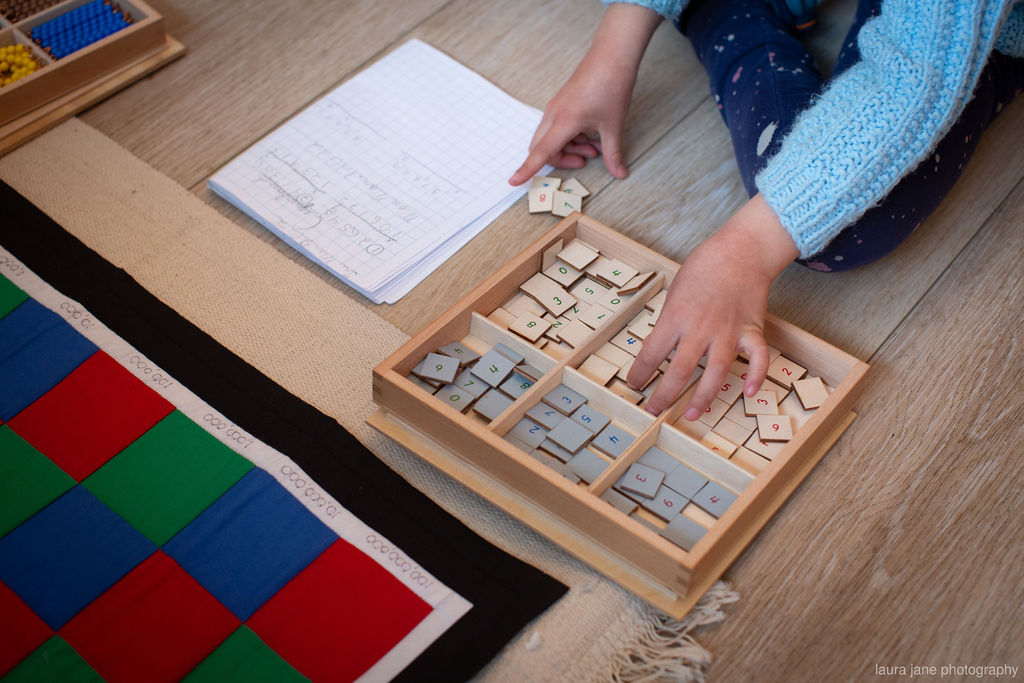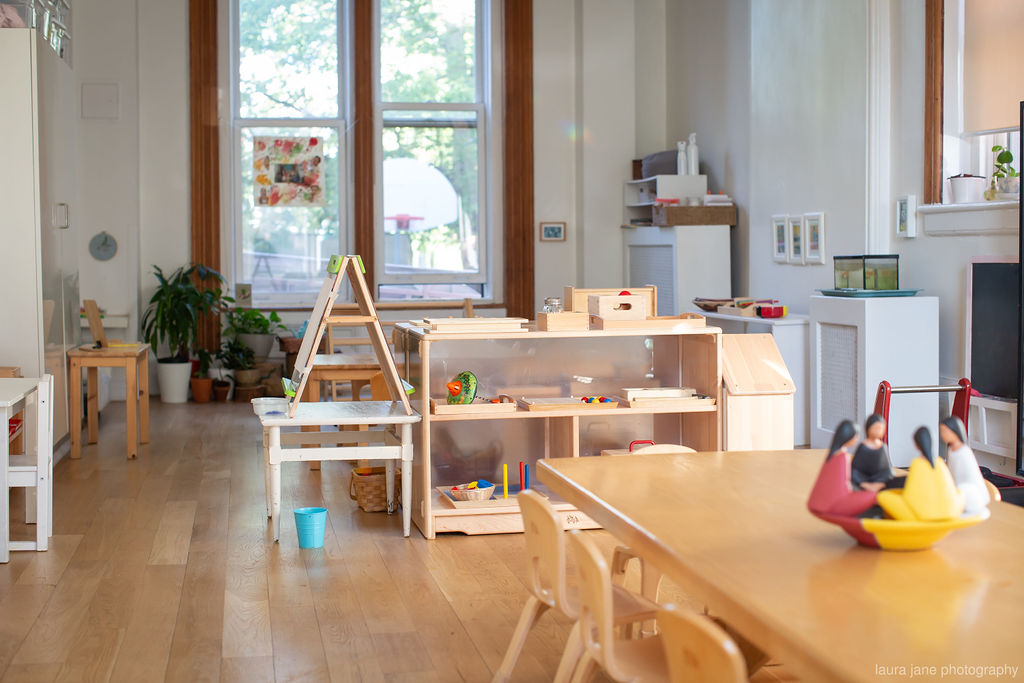The Elementary Program
Dr. Montessori designed a holistic curriculum to meet the developmental needs of the elementary child.
By repeating concepts in fresh and varied ways, children have the opportunity to work towards mastery, as well as the freedom to work at their own pace. The Montessori method uses storytelling, short presentations with materials, charts, timelines, demonstrations and experiments, as well as discussion to introduce the work and inspire the children. In Montessori, all the subjects begin with the whole, then focus in on the parts and lastly, return back to the whole, as the context gives meaning to the parts.


History
History permeates the elementary environment, and serves as a link between all areas of study: the development of language, the use of number and trading systems, the discovery of geometry, the beginnings of art and music.

Geography & Physical Science
Geography in Montessori Elementary encompasses all things connected with the earth. It is an exploration of geology, meteorology, oceanography, chemistry, astronomy and some aspects of economics presented in an integrated manner. In the second plane, children have a consuming interest in everything. That everything? The Universe!. It is introduced through the first of the great lessons, “The Story of the Universe” which and provides a context into which all other parts fit.
Read MoreGeography
Beginning with the big picture helps to lay a foundation, and gives the children a reference point, a framework, where newly acquired information can be stored and organized as they continue to explore. The imagination is the most important tool used in their geography work, as it helps them to understand what is beyond their own experience.
Materialized abstractions are used to demonstrate laws of physics such as Air Occupies Space, and models of volcanoes and rivers help represent natural environmental processes. Through these, the children come to understand both abstract and concrete concepts, and apply them to comprehend the world beyond the walls of their classroom.

Biology
The Elementary biology curriculum offers the rich language of science and nature, and an opportunity to develop and refine the skills of observation, analysis and classification, in order to further their understanding of life. Children are introduced to the six kingdoms of life as an initial foray into classification. From there, they dig into the two kingdoms which they encounter most frequently and conspicuously: plants and animals, Botany and Zoology.Our Elementary Biology Program includes Outdoor Education, through Programs run by the High Park Nature Centre and the PINE Project. Read More
Biology
The biology work gives the children a chance to practise scientific methods and further their research skills. ThroughBy studying how living things meet their needs and focusing on interdependencies, children develop respect, love, gratitude and a sense of responsibility for all life. The elementary-aged child continues to learn sensorially and through experiences. Therefore, Biology lessons include as many real specimens as possible, and are not limited to the indoors. Dr. Montessori envisioned a dual environment, where work in nature would complement and reinforce studies in the classroom.
Eventually, the children are led to explore Ecology: a coalescence of Biology and Geography. Here, the interconnections between organisms are highlighted, as well as their physical surroundings. Students examine biomes, food chains, ecosystems and matter and energy cycles. They are compelled to investigate the impacts of humans on these systems and the environment.

Mathematics
In the Montessori prepared environment, Math is made experiential. Lining the shelves are beautiful, precise, concrete materials that support children to visually conceive systems of numbers and arithmetic processes. Built upon the sensorial foundations of Casa, Elementary math is not only work of the hand, during their six years in the program, it becomes abstracted as work of the mind. The progression through the Elementary math manipulatives leads the children from work that is focused mainly on process, to written work which becomes increasingly symbolic, enabling them to check for accuracy. The children learn the rules of math as a result of their own activities; in other words, they discover them as opposed to being told, allowing for a deeper understanding and appreciation of algorithms. Read More
Mathematics
The elementary child’s reasoning and imaginative mind pushes them to explore the literally infinite world of mathematics, including properties of numbers, and numeration, work with the four operations (addition, subtraction, multiplication, division) and the order of operations, powers of numbers, integers, other base systems, fractions, decimals, squaring and cubing, as well as word problems.

Language
Literacy
While spoken language is a uniquely human characteristic that has served us for well over a million years, communication through signs is a relatively new cultural invention. In fact our brains have evolved to support language acquisition and learning to read takes more work. Humans are not hard-wired to read. In fact, each child is rewiring their brain as they learn to decode words on the page before them.
Through the Story of our Alphabet, children are introduced to the idea that humans created unique symbols to express specific ideas. As they develop their own literacy skills, children get access to this “secret code”, and they can participate in a part of history, uncovering the chapters of the story that belong to others, and then eventually writing their own.
Skilled, fluent reading with strong comprehension requires competence within a variety of “strands” of reading, which become intertwined. The two largest strands are Language Comprehension and Word Recognition. The first encompasses abilities pertaining to vocabulary, background knowledge, structure and syntax, while the latter consists of phonological awareness, decoding, and puzzle (sight) words.
Building upon the Language activities and sound games in Casa, reading instruction in elementary Through direct and individualized instruction, Westside’s Language program builds upon the activities and sound games introduced in Casa, reading instruction in elementary helps to bolster the development of phonemic awareness, phonics, vocabulary and fluency.
‘Learning to read’ paves the way for ‘reading to learn’. Through a variety of activities, children develop a skill set of active reading strategies for comprehension that include visualizing, predicting, summarizing, inferring and connecting.
Grammar & Word Study
Language instruction flows from analysis to synthesis (and back again!). Work in the elementary begins by breaking down words and sentences into their component parts to unearth meaning and understand rules.
Eight colourful grammar boxes invite the children to investigate parts of speech. Each box is presented in sequence, building upon the previous, and increasing in complexity. The introduction of each part of speech includes a story or game which gives the child a concrete experience with a concept that is largely abstract (a preposition, for instance). Through transposition work, children are made aware of syntactic rules of English they have automatically learned through spoken language acquisition. Additional studies with nouns, adjectives and verbs offer opportunities to classify and give further meaning. Beyond the grammar boxes, children use the logical analysis material to parse sentences, phrases and clauses.
Vocabulary building is an ongoing process which extends into adulthood (new words are invented every day!). The elementary classroom provides many avenues through which the children are able to acquire a broad vocabulary, several of these are included in Word Study, which facilitates the exploration of affixes, compound words, word families as well as synonyms, antonyms, homophones, homonyms, etc.
Writing
Opportunities for written composition occur organically through the child’s work in all areas of the class. Children are encouraged to write for a variety of purposes, understanding that writing may be used to inform, to entertain, to explain, and to persuade. The writing process begins with generating ideas and sourcing research materials as necessary. Upon organizing and streamlining their ideas, they begin drafting. In collaboration with peers or their guide, they proofread, and apply appropriate knowledge of grammar, spelling, punctuation. Children may choose to publish and present their work as they see fit. A scaffolded approach helps even the youngest authors participate, and throughout their time in elementary, students develop and refine their own unique voice and style in their writing.

Music
Music education begins with an appreciation for music;, and sees that opportunities for listening, singing and rhythm games are incorporated into the children’s daily work. Studies show that music has positive effects on mood, working memory, and even immunity. Moreover, training to play an instrument is believed to increase grey matter in certain areas of the brain, and has been linked to improvements in auditory processing and learning. A Montessori classroom weaves music through all subject areas; students use it to not only explore sound, but also movement, language and history. Sour students at WMS are introduced to musical theory and have the opportunity to learn to read and write music.
They use the tone bars, a Montessori material that builds on the sound bells introduced in Casa, as well as other instruments including their own voices. Further, our students attend the opera, the symphony and a variety of local concerts throughout the year.

Geometry
In the Montessori prepared environment, Math is made experiential. Lining the shelves are beautiful, precise, concrete materials that support children to visually conceive systems of numbers and arithmetic processes. Built upon the sensorial foundations of Casa, Elementary math is not only work of the hand, during their six years in the program, it becomes abstracted as work of the mind. The progression through the Elementary math manipulatives leads the children from work that is focused mainly on process, to written work which becomes increasingly symbolic, enabling them to check for accuracy. The children learn the rules of math as a result of their own activities; in other words, they discover them as opposed to being told, allowing for a deeper understanding and appreciation of algorithms. Read More
Geometry
The elementary child’s reasoning and imaginative mind pushes them to explore the literally infinite world of mathematics, including properties of numbers, and numeration, work with the four operations (addition, subtraction, multiplication, division) and the order of operations, powers of numbers, integers, other base systems, fractions, decimals, squaring and cubing, as well as word problems.

Art
Art, like music, is integrated into the curriculum and is often a part of whatever the children are doing, whether it be focusing on the history of art, or using art to explore history. The arts curriculum encompasses visual arts such as painting, sculpting and photography, as well as physical arts like theatre and dance. Through a variety of projects, children are introduced to elements of visual art such as colour, form, line, shape, space, texture, and value.
An assortment of mediums and materials are made available to children in the classroom so that they may design and create as soon as they’re feeling inspired. Exposure to and experience within the arts is known to support development of creativity, confidence, problem solving, perseverance, focus, non-verbal communication, receiving constructive feedback, collaboration, dedication and accountability.

Physical Education
Physical education is a vital part of any elementary program, essential to the development of strong healthy minds and bodies. Through regular afternoon physical education classes led by our Physical Education Instructor, as well as specialty classes, children are introduced to a variety of physical activities, which may include soccer, basketball, lacrosse, track and field, martial arts, dance, volleyball, rock climbing, skating and skateboarding, each running for 3-4 weeks throughout the year.
We aim to offer our students ample time to allow them to get a feel for each new activity or sport it, and perhaps even discover a hidden talent. WMS is a part of the Independent Schools Athletic Association and our students partake and organise sporting events with other independent schools such as soccer and basketball tournaments as well as track and field days. These special days provide opportunities for learning and practising sportsmanship and team spirit!

Digital Technology & Computers
We take seriously our responsibility to make thoughtful decisions about when and how technology is introduced. Digital education should not only include the operation of hardware, software, and the Internet, but also social media. In terms of using digital technology as a research tool, children are prepared by first mastering certain skills so they are not overwhelmed by The Internet’s wealth of information, and they can discern its quality of various sources.
Books and encyclopedias allow children to develop research skills, and it has been proven that hard copies lend themselves to better navigation and reading comprehension than screens. Technology is introduced towards the end of lower elementary. As with all other work, the timing of computer work depends on the child’s readiness and interest.

Going Out
Because elementary children are naturally curious about how the world works, many Montessori materials, such as those in sciences, and social sciences, are purposefully limited to create a need to explore the actual world beyond the classroom walls. These explorations may take place in the library, museums, institutes, parks or even local shops and businesses and offer the children meaningful learning opportunities, beyond just what they discover about the topic being explored. These outings are student-led from beginning to end.
This process involves will have them planning from the proposal stage, to mapping out how to get to their destination, to knowing the hours and costs involved. It requires learning how to appropriately and politely acquire information from people over the phone or via email and in person and showing and, of course showing appreciation to those who are helpful by sending thank you notes. The natural consequences they may face due to lack of planning are invaluable learning experiences, as are their successes.









Our Core Objectives
Every child is an individual, captivated by different things at different times. We personalize your child’s learning experience by creating individualized lesson plans based on their interests, level of understanding and experiences. In this manner, every child is introduced to all aspects of our curriculum at the right time in their development.
Children who graduate our program will be prepared for the next step in their education, private or public, with a genuine love of learning. They will have an increased curiosity about the world around them and the confidence necessary to take on new academic and social challenges.

From our first visit to the school, we were taken by the warm and inspiring environment. The experience we’ve had for the last 3 years is one that we can’t recommend highly enough. The teachers are not only passionate about Montessori learning in their classroom but also connected with the parents to bridge that gap in the home environment
Laura Jane & Nick
Parents
